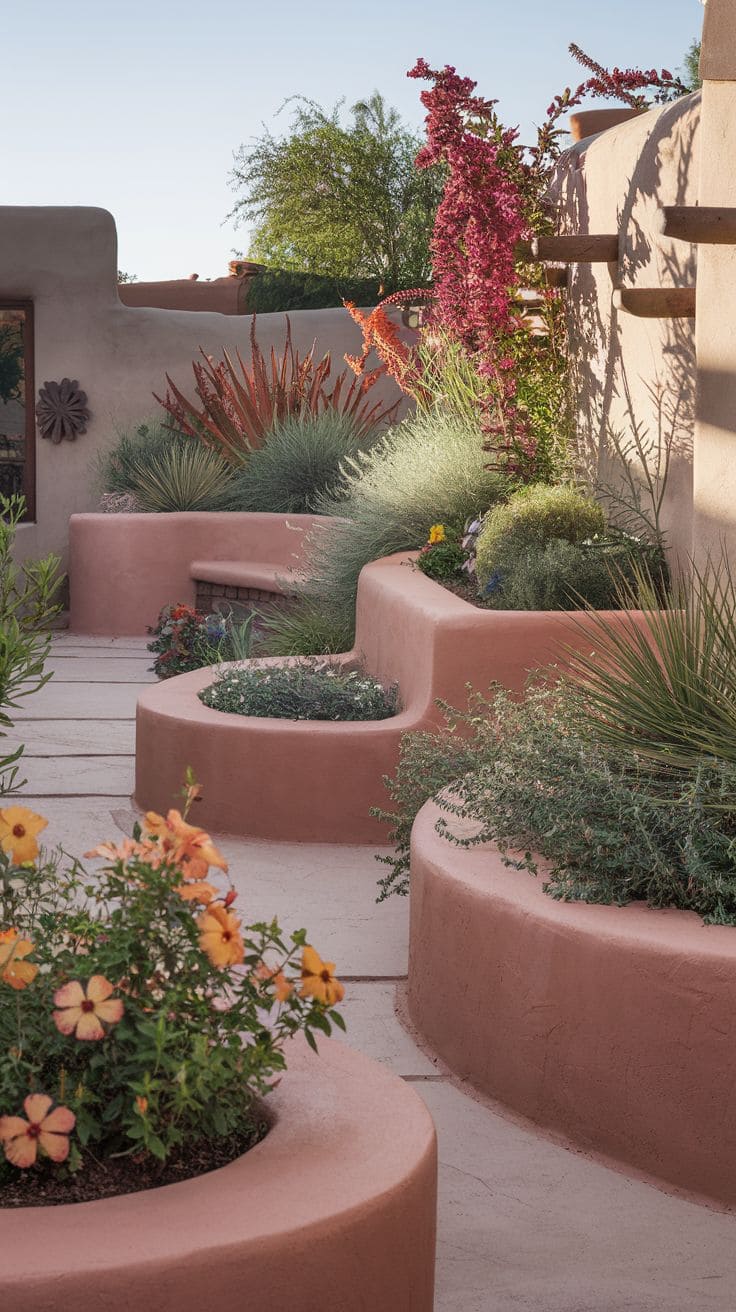Southwest landscaping captures the beauty of arid climates and turns them into vibrant, earthy, and incredibly textured outdoor spaces. Drawing inspiration from the desert, Indigenous traditions, and Spanish influences, this style wants to celebrate the dryness of the land.
This design approach works beautifully for those seeking a low-maintenance yard that still feels soulful and artistic, connecting home and land in a natural, expressive way. These Southwest landscaping ideas are sure to boost the style of your home.

1. Cactus & Succulent Rock Garden

A cactus and succulent garden hidden in a bed of rocks and gravel is a well-known feature of Southwest gardening.
Begin with warm-toned decomposed granite or crushed stone as your ground cover, then add agave, golden barrel cactus, and echeveria throughout.
To break up the texture, cluster the plants in groups of varied heights and provide room for sculptural pieces such as driftwood or hand-painted earthenware.
The allure is in the contrast: spiky forms growing from smooth stones, with shadows cast vividly across the uneven ground.
This garden layout is not only visually appealing, but also ideal for water saving and easy maintenance, making it both a useful and beautiful focus.



2. Adobe-inspired Raised Beds and Planters

Adobe-style walls and planters help define spaces while maintaining a consistent look. These elements, which are generally composed of earthen-toned concrete or stucco, look great with vibrant blooms like Mexican primrose, desert marigold, or penstemon.
Create a curved raised bed along the edge of a patio or sidewalk and paint it a warm terracotta or sun-baked clay colour.
To create a structural but organic effect, arrange rounded adobe planters filled with prickly yuccas or flowing decorative grasses next to seating spaces.
The softened curves of adobe building provide a relaxed, earthy environment, grounding your yard in classic desert design while allowing your flora to bloom.



3. Terracotta Pot Garden Display

Nothing better portrays the essence of the Southwest than a cluster of terracotta pots overflowing with life.
To create visual layers, fill pots of varied heights and diameters with drought-tolerant plants such as aloe, trailing lantana, or purple sage.
To create a striking contrast, place them along paths, front doors, or against stucco walls.
Try arranging five or more in a corner nook and adding color with painted pots or ornamental tiles underfoot.
These containers are simple to move and rearrange, offering you flexibility for seasonal changes or party setups. Furthermore, their earthy tones fit wonderfully with the pleasant desert landscape.



4. Mesquite or Palo Verde Shade Trees

Mesquite and palo verde trees are endemic to the Southwest and provide structure, shade, and movement.
Their open canopies enable filtered light to flow through, allowing understory vegetation to grow while providing shade from the sun.
Plant one near a patio or pathway, then surround it with gravel mulch and low-growing perennials.
These trees provide more than just shade; their twisting trunks and feathery foliage provide sculptural elegance, and in the spring, palo verdes bloom in golden hues.
Integrating native trees ties your yard to the larger environment while adding timeless elegance with low upkeep requirements.
Having these wonderful trees in your yard will give you plenty of shade while keeping the area looking lush.



5. Colorful Desert Wildflower Patch

Dedicate a corner of your yard to native desert wildflowers for bursts of color. Blanketflower, desert bluebells, California poppies, and blackfoot daisies flourish in arid areas and support pollinators.
Sow seeds in curved, organic shapes and surround the area with flat stones or decorative edging.
Wildflower patches add gentleness to stone-heavy landscapes and provide seasonal drama.
Enhance the charm by adding rustic signage or a weathered bench nearby.
The beauty of this setup is that it is mostly self-sufficient once built and gives a welcoming layer of color and liveliness to an otherwise neutral-toned environment.



Plant Selection for Southwest Landscapes
Agave

Yucca

Prickly Pear Cactus

Sagebrush

Hardscaping Ideas
Rock Gardens

Gravel Pathways


Terracotta Elements

Stone Walls and Borders

Water Features for Southwest Landscapes
Desert-Inspired Fountains

Dry Riverbeds

Reflecting Pools

Outdoor Living Spaces
Patios and Seating Areas

Fire Pits and Fireplaces

Shade Structures

Decorative Elements
Southwest Art and Sculptures

Colorful Mosaics and Tiles

Decorative Planters

Additional Landscaping Ideas
Xeriscaping Techniques

Edible Gardens

Conclusion






Southwest landscaping captures the soul of the desert. The way it is truly resilient, colorful, and full of character. With an emphasis on low water use, organic shapes, and natural materials, it offers a peaceful harmony between home and environment.
The warmth of terracotta, the texture of stone, and the sculptural beauty of native plants come together to create spaces that are grounded, inspiring, and easy to maintain.
If these landscaping ideas helped, leave a comment below and share this article with your friends!

